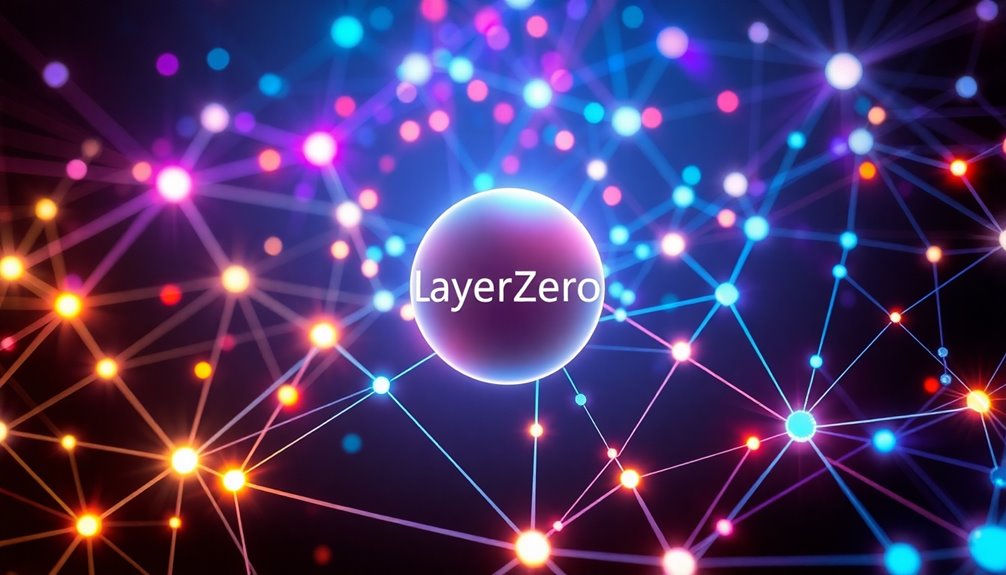LayerZero transforms blockchain interoperability by enabling effortless communication between diverse networks. It utilizes Ultra Light Nodes (ULNs) for efficient cross-chain message verification while oracles and relayers ensure accurate data. LayerZero's customizable security stacks let you tailor access controls, making it adaptable to your specific needs. Plus, it simplifies cross-chain transactions through an automated execution system. This decentralized architecture enhances security and transparency, crucial for decentralized finance (DeFi) applications. With its cutting-edge features, LayerZero is an essential player in the evolving blockchain landscape, paving the way for next-gen solutions. Discover how it can benefit your projects further.
Key Takeaways
- LayerZero utilizes Ultra Light Nodes to verify cross-chain messages efficiently, reducing resource demands for blockchain interoperability.
- The protocol supports seamless communication between diverse blockchain networks through decentralized architecture and modular design.
- LayerZero enhances decentralized finance (DeFi) applications by enabling secure cross-chain transactions and transparent data sharing among platforms.
- Customizable security stacks allow users to tailor access controls, enhancing trust while managing potential vulnerabilities in cross-chain interactions.
- Future trends in interoperability include dynamic signers in multi-signature wallets and the minting of Chain NFTs across multiple networks, boosting ecosystem expansion.
Core Concepts of LayerZero

When exploring the core concepts of LayerZero, you'll find that its innovative architecture revolutionizes blockchain interoperability.
At its heart are Ultra Light Nodes (ULNs), which verify cross-chain messages efficiently without the heavy resource demands of traditional nodes. Oracles and relayers play crucial roles, providing accurate data feeds and ensuring historical data accuracy.
LayerZero Endpoints serve as immutable entry and exit points across supported blockchains, while customizable Security Stacks allow for unique access controls. Additionally, the Executor automates message delivery after verification, simplifying interactions. This architecture not only enhances communication between networks but also strengthens security and scalability, making LayerZero a game-changer in the blockchain landscape. Moreover, it supports operations across 100+ blockchains, highlighting its extensive reach and versatility in the ecosystem.
Overview of Blockchain Interoperability

Blockchain interoperability is essential for the future of decentralized networks, as it allows different blockchains to communicate and share data seamlessly. However, achieving this isn't straightforward.
You'll face technical challenges like diverse consensus mechanisms and varying architectures, which complicate the development of effective solutions. Data format incompatibilities further hinder exchanges between systems. Effective interoperability is essential for a secure and reliable cross-chain economy, highlighted by over $2.8 billion in user funds lost due to insecure cross-chain token bridges.
Security risks also emerge; cross-chain bridges might expose vulnerabilities, risking user funds. Additionally, the lack of standardization across protocols and governance hurdles adds to the complexity.
While projects like Polkadot and Cosmos strive for standard protocols, widespread adoption remains limited. To succeed, developers must navigate these obstacles, often creating custom solutions to bridge the gaps between different blockchain networks.
Cross-Chain Messaging Protocol

LayerZero’s Cross-Chain Messaging Protocol revolutionizes how blockchains interact by enabling seamless communication between different networks. This innovative approach allows for the transfer of assets and data across various blockchain ecosystems without the need for intermediaries, thereby enhancing efficiency and reducing costs. Among its key features is the concept of ‘sidechain compression explained in detail,’ which streamlines transactions by minimizing the data required to be processed on the main chain. As a result, LayerZero fosters a more interconnected blockchain landscape, paving the way for new decentralized applications that leverage the strengths of multiple networks.
Its decentralized architecture enhances security and transparency, while the modular design allows easy integration with various blockchain systems. You'll appreciate the multiple interoperability layers that support asset transfers and smart contract execution.
With asynchronous messaging, the protocol ensures efficient communication and reliable message delivery, crucial for real-time interactions. It's blockchain agnostic, compatible with platforms like Ethereum and Binance Smart Chain.
Advanced encryption secures your data in transit, and a network of nodes verifies messages for integrity.
Whether in decentralized finance, NFT trading, or supply chain management, this protocol is designed to handle high transaction volumes and real-world applications effortlessly.
Pros and Cons Analysis

As cross-chain messaging gains traction, it's important to weigh the advantages and disadvantages of LayerZero.
On the plus side, LayerZero offers enhanced security through decentralized oracles and relayers, ensuring trust and censorship resistance. Its Ultra Light Nodes (ULNs) enhance efficiency and scalability by streamlining cross-chain verification, making it cost-effective. Additionally, LayerZero has facilitated the transfer of over $50 billion in value(over $50 billion) through its protocol, highlighting its effectiveness in real-world applications.
You'll also appreciate the flexibility, as you can customize security parameters and choose your Oracle and Relayer services.
However, potential drawbacks include the complexity of implementing customizable trust levels, which might overwhelm some users. Additionally, reliance on decentralized systems can introduce vulnerabilities if not properly managed.
Balancing these pros and cons is crucial as you navigate the evolving landscape of blockchain interoperability.
LayerZero vs. Traditional Solutions

While traditional solutions typically rely on a middle-chain approach for cross-chain communication, LayerZero revolutionizes this concept with its Ultra Light Node architecture. This design eliminates the need for resource-heavy intermediaries, reducing the risk of single points of failure.
Instead, LayerZero utilizes decentralized oracles to stream block headers on demand, ensuring efficient and secure data transfer. You'll appreciate the customizable trustlessness that allows you to adjust security parameters based on your needs. In fact, LayerZero's innovative design has led to integration with over 80 networks, enhancing scalability and operational efficiency.
Compared to traditional solutions, which often struggle with speed and cost, LayerZero's direct communication model delivers faster and more cost-effective cross-chain transactions, making it a compelling choice for developers and users alike.
Security Vulnerabilities in Protocols

When exploring blockchain interoperability, understanding security vulnerabilities in protocols is crucial.
You should be aware of routing attacks, where attackers can intercept consensus requests, partition networks, and publish false routing information, crippling transactions. Transparency in block generation enhances trust in information transmission, making it vital to address these risks.
Additionally, Sybil attacks involve creating fake identities, allowing malicious actors to control network traffic and block transactions, potentially exposing sensitive information.
Then there are 51% attacks, where an attacker controls over half of the computational power, threatening the integrity of the blockchain by creating fake pools and parallel chains.
Lastly, extrinsic security threats, particularly in cross-chain bridges, pose significant risks as hackers exploit smart contracts, leading to potential financial losses.
Staying vigilant against these vulnerabilities is essential for a secure blockchain experience.
Emerging Cross-Chain Defi Applications

Emerging cross-chain DeFi applications are revolutionizing how you interact with decentralized finance, offering unprecedented flexibility and efficiency.
Cross-chain decentralized exchanges (DEXs) enable direct trading of native assets without wrapped tokens, streamlining your trading experience. These platforms leverage cross-chain technology to facilitate seamless transactions across different blockchain networks.
You can also take advantage of multi-chain yield aggregators, optimizing yields across various networks while maintaining transparency and security.
For lending, cross-chain platforms allow you to lend and borrow digital assets seamlessly, enhancing accessibility and efficiency.
These platforms utilize automated market makers and atomic swaps to ensure smooth transactions.
Additionally, cross-chain NFTs and name services let you mint NFTs and manage digital identities across networks, amplifying the utility of your assets.
Embrace the future of DeFi with these innovative solutions.
Utilize Multi-Signature Wallets

Utilizing multi-signature wallets can significantly enhance your security in the decentralized finance landscape. These wallets require multiple signatures to authorize transactions, providing decentralized control and protecting against single-point failures. By managing several private keys, they ensure no single entity controls all the funds, minimizing theft risks. Multi-signature wallets also verify transactions through multiple parties, reducing fraud likelihood and creating immutable, tamper-proof records. You can customize thresholds for signatures, adapting to your security needs, while dynamic signers allow flexibility.
Integrating with LayerZero enables secure cross-chain transactions, supporting various blockchain networks. This combination enhances your DeFi applications, ensuring transparency and compliance while offering role-based access for authorized actions. Moreover, utilizing LayerZero's flexibility allows you to choose the benefits of different chains for your dApp development. Embrace multi-signature wallets for improved security and efficiency.
Frequently Asked Questions
How Does Layerzero Handle Transaction Fees Across Different Blockchains?
When you're dealing with transaction fees across different blockchains, LayerZero doesn't set a fixed fee structure. Instead, it relies on the consensus protocols of the target blockchain.
You'll notice that various blockchains have unique fee mechanisms, and the Relayer incurs costs for processing and storage. Additionally, smart contract execution and oracle data can add extra fees.
This variability means you should consider these factors when planning cross-chain transactions.
Can Layerzero Support Non-Fungible Tokens (NFTS) Across Chains?
Yes, LayerZero can support non-fungible tokens (NFTs) across multiple chains.
You'll be able to buy and sell Omnichain NFTs seamlessly, thanks to its integration with marketplaces like Magic Eden. This setup allows you to swap NFTs effortlessly between Ethereum and Polygon, enhancing your trading experience.
The use of Ultra-Light Nodes and Decentralized Verifier Networks ensures secure and efficient transactions, making cross-chain NFT operations smooth and reliable for you.
What Programming Languages Are Compatible With Layerzero?
You might think that only one programming language can dominate blockchain development, but that's not true.
LayerZero supports several languages. Primarily, you'll use Solidity for smart contracts, but Rust is also vital for security and efficiency.
JavaScript lets you script and test your applications, while TypeScript helps maintain code quality.
This diverse compatibility allows you to create robust, cross-chain interactions that suit your development needs and preferences.
How Does Layerzero Achieve Consensus Across Multiple Chains?
To achieve consensus across multiple chains, you rely on Ultra Light Nodes (ULNs) that validate transactions efficiently using minimal resources.
These nodes facilitate direct communication between chains, eliminating the need for intermediaries.
Additionally, oracles and relayers ensure accurate data transfer and secure transactions.
With customizable trustlessness, you can adjust security settings based on your needs, all while enjoying blockchain-agnostic compatibility for seamless asset movement and cross-chain applications.
Are There Any Specific Wallets Recommended for Using Layerzero?
If you're diving into LayerZero, you'll want the right wallets to manage your assets securely.
Recommended options include YouHodler for its versatile desktop and mobile wallets, Ledger for robust hardware support, and Trezor for long-term storage.
You'll also find MetaMask handy for managing multiple chains effortlessly.
Each wallet has unique features, so consider your needs and choose accordingly to enhance your crypto experience.
Conclusion
In the evolving landscape of blockchain, LayerZero stands out, bridging the gap between disparate networks while traditional solutions falter in flexibility. You'll find that its cross-chain messaging protocol offers unprecedented interoperability, yet it's not without risks. Balancing innovation with security, LayerZero opens doors to emerging DeFi applications, yet invites scrutiny over vulnerabilities. As you navigate this dynamic space, weigh the promise of seamless connectivity against the necessity for robust safeguards, shaping the future of digital assets.









